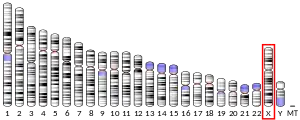OPHN1
Oligophrenin-1 is a protein that in humans is encoded by the OPHN1 gene.[5][6][7]
Function
Oligophrenin 1 has 25 exons and encodes a Rho-GTPase-activating protein. The Rho protein are important mediators of intracellular signal transduction, which affects cell migration and cell morphogenesis.
Clinical significance
Mutations in this gene are responsible for non-specific X-linked intellectual disability (previously called mental retardation).[7]
OPHN1 syndrome is a rare disorder characterized by intellectual disability and changes in the part of the brain which controls movement and balance (cerebellum). The syndrome mainly affects males. It is characterized by low muscle tone (hypotonia), developmental and cognitive delay, early-onset seizures, abnormal behavior, characteristic facial features (long face, bulging forehead, under eye creases, deep set eyes, and large ears), crossed eyes (strabismus) and inability to coordinate movements.[8] [9] A small cerebellum and large ventricles can be seen on brain imaging (MRI).[8][10][11] Treatment is supportive and includes physical, occupational and speech and language therapy.[12] In 2014 an OPHN1 patient organization and website was formed to support families and promote OPHN1 syndrome research. [13]
OPHN1 syndrome is caused by mutations in the OPHN1 gene, which is located on the X chromosome. Inheritance is X-linked.[8] Some females who carry a mutation in the OPHN1 gene may have mild learning disabilities, mild cognitive impairment, strabismus, and subtle facial changes.[7]
References
- GRCh38: Ensembl release 89: ENSG00000079482 - Ensembl, May 2017
- GRCm38: Ensembl release 89: ENSMUSG00000031214 - Ensembl, May 2017
- "Human PubMed Reference:". National Center for Biotechnology Information, U.S. National Library of Medicine.
- "Mouse PubMed Reference:". National Center for Biotechnology Information, U.S. National Library of Medicine.
- Bienvenu T, Der-Sarkissian H, Billuart P, Tissot M, Des Portes V, Brüls T, Chabrolle JP, Chauveau P, Cherry M, Kahn A, Cohen D, Beldjord C, Chelly J, Cherif D (Aug 1997). "Mapping of the X-breakpoint involved in a balanced X;12 translocation in a female with mild mental retardation". European Journal of Human Genetics. 5 (2): 105–9. doi:10.1159/000484743. PMID 9195162.
- Billuart P, Bienvenu T, Ronce N, des Portes V, Vinet MC, Zemni R, Roest Crollius H, Carrié A, Fauchereau F, Cherry M, Briault S, Hamel B, Fryns JP, Beldjord C, Kahn A, Moraine C, Chelly J (April 1998). "Oligophrenin-1 encodes a rhoGAP protein involved in X-linked mental retardation". Nature. 392 (6679): 923–6. Bibcode:1998Natur.392..923B. doi:10.1038/31940. PMID 9582072.
- "Entrez Gene: OPHN1 oligophrenin 1".
- Zanni G, Bertini ES (May 2011). "X-linked disorders with cerebellar dysgenesis". Orphanet Journal of Rare Diseases. 6: 24. doi:10.1186/1750-1172-6-24. PMC 3115841. PMID 21569638.
- "OPHN1". Genetics Home Reference. 2016.
- Zanni, Ginevra (February 2013). "X-linked intellectual disability-cerebellar hypoplasia syndrome". Orphanet.
- Bedeschi MF, Novelli A, Bernardini L, Parazzini C, Bianchi V, Torres B, Natacci F, Giuffrida MG, Ficarazzi P, Dallapiccola B, Lalatta F (July 2008). "Association of syndromic mental retardation with an Xq12q13.1 duplication encompassing the oligophrenin 1 gene". American Journal of Medical Genetics. Part A. 146A (13): 1718–24. doi:10.1002/ajmg.a.32365. PMID 18512229.
- "OPHN1 therapies". Oligophrenin-1 Syndrome Foundation.
- "OPHN1 therapies". Oligophrenin-1 Syndrome Foundation.
Further reading
- Castellví-Bel S, Milà M (February 2001). "Genes responsible for nonspecific mental retardation". Molecular Genetics and Metabolism. 72 (2): 104–8. doi:10.1006/mgme.2000.3128. PMID 11161835.
- Ramakers GJ (April 2002). "Rho proteins, mental retardation and the cellular basis of cognition". Trends in Neurosciences. 25 (4): 191–9. doi:10.1016/S0166-2236(00)02118-4. PMID 11998687.
- Bergmann C, Zerres K, Senderek J, Rudnik-Schoneborn S, Eggermann T, Häusler M, Mull M, Ramaekers VT (July 2003). "Oligophrenin 1 (OPHN1) gene mutation causes syndromic X-linked mental retardation with epilepsy, rostral ventricular enlargement and cerebellar hypoplasia". Brain. 126 (Pt 7): 1537–44. doi:10.1093/brain/awg173. PMID 12805098.
- Tentler D, Gustavsson P, Leisti J, Schueler M, Chelly J, Timonen E, Annerén G, Willard HF, Dahl N (July 1999). "Deletion including the oligophrenin-1 gene associated with enlarged cerebral ventricles, cerebellar hypoplasia, seizures and ataxia". European Journal of Human Genetics. 7 (5): 541–8. doi:10.1038/sj.ejhg.5200320. PMID 10439959.
- Billuart P, Chelly J, Carrié A, Vinet M, Couvert P, McDonell N, Zemni R, Kahn A, Moraine C, Beldjord C, Bienvenu T (2000). "Determination of the gene structure of human oligophrenin-1 and identification of three novel polymorphisms by screening of DNA from 164 patients with non-specific X-linked mental retardation". Annales de Génétique. 43 (1): 5–9. doi:10.1016/S0003-3995(00)00015-0. PMID 10818214.
- Pinheiro NA, Caballero OL, Soares F, Reis LF, Simpson AJ (October 2001). "Significant overexpression of oligophrenin-1 in colorectal tumors detected by cDNA microarray analysis". Cancer Letters. 172 (1): 67–73. doi:10.1016/S0304-3835(01)00625-5. PMID 11595131.
- Kitano T, Schwarz C, Nickel B, Pääbo S (August 2003). "Gene diversity patterns at 10 X-chromosomal loci in humans and chimpanzees". Molecular Biology and Evolution. 20 (8): 1281–9. doi:10.1093/molbev/msg134. PMID 12777533.
- Philip N, Chabrol B, Lossi AM, Cardoso C, Guerrini R, Dobyns WB, Raybaud C, Villard L (June 2003). "Mutations in the oligophrenin-1 gene (OPHN1) cause X linked congenital cerebellar hypoplasia". Journal of Medical Genetics. 40 (6): 441–6. doi:10.1136/jmg.40.6.441. PMC 1735502. PMID 12807966.
- Xiao J, Neylon CB, Nicholson GA, Furness JB (2004). "Evidence that a major site of expression of the RHO-GTPASE activating protein, oligophrenin-1, is peripheral myelin". Neuroscience. 124 (4): 781–7. doi:10.1016/j.neuroscience.2004.01.007. PMID 15026118.
- Zanni G, Saillour Y, Nagara M, Billuart P, Castelnau L, Moraine C, Faivre L, Bertini E, Durr A, Guichet A, Rodriguez D, des Portes V, Beldjord C, Chelly J (November 2005). "Oligophrenin 1 mutations frequently cause X-linked mental retardation with cerebellar hypoplasia". Neurology. 65 (9): 1364–9. doi:10.1212/01.wnl.0000182813.94713.ee. PMID 16221952.



